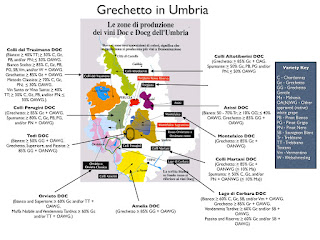My research revealed that a single Grechetto variety had been listed on the National Register of Vine Varieties since 1970 but that genetic work done in 2013 had shown that two distinct varieties existed: Grechetto di Orvieto (clone G5) and Grechetto di Todi (clone G109). Prior to 2013, then, these varieties would have been unknowingly blended together.
The characteristics of the varieties are shown in the chart below.
Both varieties originated in Greece but are now inextricably linked to the wine regions of Central Italy. Grechetto di Orvieto is planted throughout the home range but is most famous for its role in the wines of Orvieto DOC in Umbria and Lazio. The wine is generally used in blends (with one or more of the following varieties: Chardonnay, Malvasia, Trebbiano, Verdello) where it adds richness and structure plus citrus and dried-nut characteristics. However, a number of the regional DOCs permit varietal wines from this grape. The wines from this grape are generally light-bodied and high in acidity. Synonyms for the variety are Grechetto, Greghetto, Grechetto Spoletino, Greco Spoletino, and Greco Bianco di Perugia.
Grechetto di Todi wines are generally considered superior to Grechetto di Orvieto wines. the grape shows some similar identifying traits as the Grechetto di Orvieto but has the same DNA as the Pignoletto variety. As a wine, Gentile has a more pronounced freshness and is more aromatic and less almondy than the Grechetto di Orvieto. It also has a signature bitter finish.
The figure Immediately bellow summarizes the DOCs and regions wherein one finds the two Grechetto varieties while the details from each region are provided in the Appendix.
As I mentioned previously, I have tasted and documented some past tastings of Grechetto wines. The first is Marco Caprai's 100% Grechetto from Colli Martani DOC. We tasted the 2018 Grechetto Grecante as we milled around the bar at West Palm Wines prior to a Caprai tasting. The wine was perfumed, floral, waxy and with yellow fruit on the nose. Herbs, a bitterness, textured and mineral on the palate. The minerality and texture combined to restrain the fruit flavors. Interesting mix of acidity, bitterness, and minerality. Textural intensity diminished with time. I loved this wine so much that I bought half a case.
The 2015 Greco di Renabianca is a 100% Grechetto which is labeled Umbria Bianco IGT. I tasted this wine while on a visit to Terre Margaritelli in Torgiano, Umbria. This wine is named after a 12th century soldier, recalling the myriad battles between towns that took place in the flat lands below the estate. Aged 2- 3 months in barrique and 1 year in bottle. This wine brought to mind sweet hazelnuts, eucalyptus and white fruits. Lime, spice and a rusticity on the palate. Powerful.
Appendix: Instances of Grechetto and Grechetto Gentile in Central Italy
©Wine -- Mise en abyme








No comments:
Post a Comment